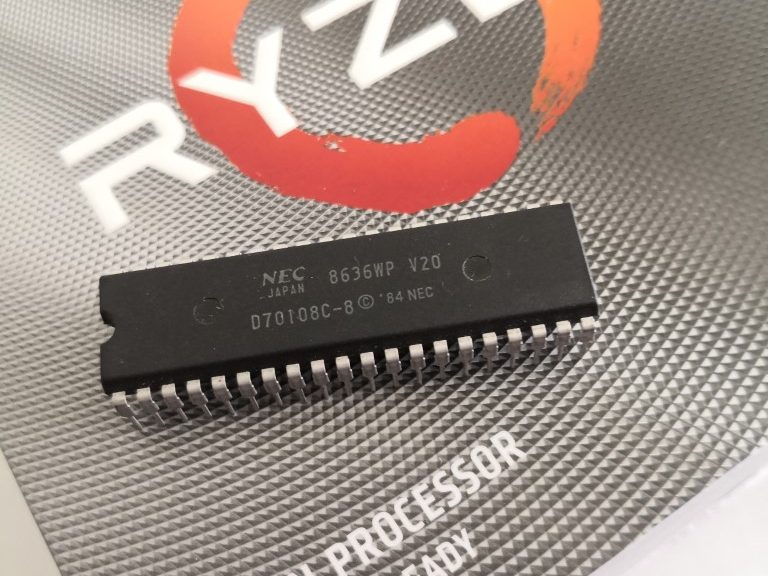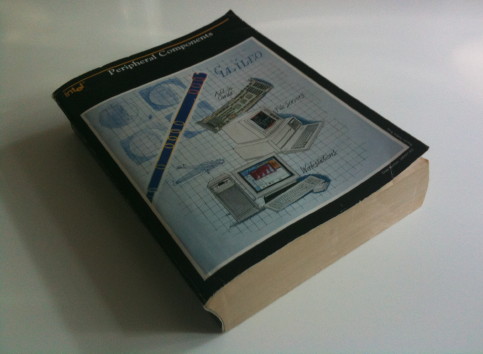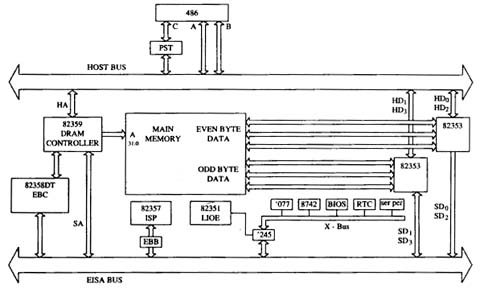In Jan 2020 was planning to build a new PC, after using its predecessor for 8 years. Now that I’m done, I thought “hey, how many PC builds have I done already?” – Well let’s count while having a stroll down memory lane:
[Yes, I’m a ‘real man’ thus I never owned an off-the-shelf PeeCee]
1988 – The entry
I got my first x86 computer (built from parts) in exchange for working at a local computer shop – Even I was totally happy with my Atari ST, I was intrigued by the many ways of hard- and software hacking possible… and of course by its quirkiness, i.e x86, strange offset/segmented memory access etc.
It was much worse than my Atari in every aspect except having a hard-drive which for the Atari would have cost me as much as the complete XT System:
- CPU: NEC V20, 8MHz (overclocked to 10MHz after some weeks)
- Mainboard: No-Name 8088, fully populated with 640KB and 5 ISA slots
- Video: No-Name Hercules compatible (to an amber 12″ screen)
- Media: Seagate ST-225, glorious 20MB, MFM controller and a 360KB 5.25″ Floppy drive
It was fun hacking my way through Turbo-C/ASM, TSRs and such but even overclocked it was a sloth…
1990 – Affordable 32bit! And an option of UNIX…
About quitting my job at the computer store I traded my XT for a bare 80386 system on my way out. Bare because I had no money left for a case… and also because having a ‘proper SCSI’ solution was more important to me after seeing Interactive UNIX running at a friends system I planned to have that too, some fine day… so this “PC” was running lying naked on my desk. It consisted of
- CPU: AMD 80386, 33MHz
- Mainboard: No-Name 386, populated with 4MB and five 16-bit ISA slots
- Video: No-Name Trident 8900, 512K (IIRC)
- Media: A 5.25″, full-hight 170MB SCSI monster (I think it was Micropolis and already considered vintage – but cheap!) attached to a fancy (and very much loved) Adaptec 1542b – and a 1.4MB 3.5″ floppy of course.
It turned out that there was no way to get a proper UNIX for cheap – and it wasn’t planned to pursue this path any further…
(During these days in my view Apple and Acorn still were the things to come – it shows how wrong you can be)
1992 – Linux happened
Early 1992 I got wind of this Finnish guy and his ‘tuned MINIX’ – digging into the news further I was on fire, got myself a ~40 Floppy Distro (A Slackware clone from ‘Linux Support Team Erlangen’) and immediately understood, that a 386 and 4MB isn’t much if you want X11, too.
So I swapped my x86 again and got myself a 80486/33 which I originally bought as office workhorse for my first own company (which did not work out so well). Having doubled the RAM this also brought a speedy ET4000 with a whopping 1MB video-RAM making X11 possible.
- CPU: Intel 80486, 33MHz
- Mainboard: No-Name 486, populated with 8MB and five 16-bit ISA slots
- Video: ET4000, 1MB
- Media: Replaced the lame AT-BUS by my SCSI rig from above.
1994 – Going serious
Finally I was in UNIX heaven… and using a UNIX system (Linux in this case) you never have a sufficiently fast system. It became clear that my 33MHz 486 hit its limits and even my dear AHA1542B felt slow looking at this brand new PCI-Bus everybody was going crazy about. So I skipped EISA and looked for the best solution.
Attending the release show [German] of the brand new Intel Pentium at Cebit ’93 it became clear that I’ll ignore that an go for an Am5x86 and the best board you can get: The ASUS PCI/I-486SP3G
- CPU: AMD 5×86, 133MHz
- Mainboard: Asus 468SP3G with 16MB, four 16-bit ISA and 3 PCI slots
- Video:ET4000 (replaced in 1995 by an S3 Trio64, 2MB)
- Media: Onboard NCR53c810 SCSI driving a 3.5″ 200MB HD and 2x CD-ROM
1996 – Bad Ass mode
Compiling kernels and stuff like that squeezed the last inch of performance out of my trusty 5×86 (now running at 160MHz) it had to be something faster again… Having some cash at hand I decided to go “32bit and no way back” and opted for the cool & huge Pentium PRO @ 200MHz which I got for a very good price (used, from an integrator evaluation site) before I even had a board for it.
After some research it had to be the bad-ass Tyan S1662D mainboard, featuring a 2nd socket to go dual CPU – how crazy it that!? A year later, that socket got populated and besides my Linux power-house (make -j2!) this box also rendered Cinema-4D movies like a maniac (I even was beta-tester for Maxxon).
- CPU: 2x Intel Pentium Pro/200
- Mainboard: Tyan S1662D with 32MB, tree 16-bit ISA and 5 PCI slots. Stuffed to 256MB later.
- Video: S3 ViRGE/VX 2MB, replaced by later by a very much loved Nvidia Riva 128/4MB
- Media: Symbios Logic 53C875 PCI SCSI controller driving a 3.5″ 500MB HD and 2x CD-ROM
1999 – Last x86 update for a long time
Finishing my studies I mainly used my beloved PowerMac 6100 for creative work, while my ‘Pro’ was Linux and render-box only.
I started a day-job in IT earning real money and had the chance of hosting my server – so the PPro became my first physical server hosting this very page (and others). So I needed to get into PC builds gain – even I can’t remember a real reason for this 😉
Intels Pentium-II easily outperformed my two PPros already and AMD did not convince me with their product line, so it became an PII @ 333MHz and an Asus P2B-F board which ran solid as a rock… but when my iMac G4 with OS X moved in, I got the perfect UNIX/BSD system I ever wanted and this little PCs fate was clear… it replaced the PPro Webserver. The PC-at-home time ended…
- CPU: Intel Pentium II 333MHz
- Mainboard: Asus P2B-F with 512MB, tree 16-bit ISA and 5 PCI slots
- Video: AGP Riva TNT
- Media: ATA became cheaper and faster than affordable SCSI. So this was the end of an era.
The Orphan
In 2012 I inherited my work PC when they closed office and I was pink slipped. Well, if it’s free… and a nice system it was: The Intel i7 2600K is still considered a decent CPU and was an animal back then. The Gigabyte z68x-ud3 mainboard neither is a bad choice (if you don’t need the beta UEFI BIOS) and this box made a strong gaming box with some casual VM and Hackintosh experiments… but beyond that, Macs-only it was from 2000 up to now.
- CPU: Intel i7 2600K
- Mainboard: Gigabyte z68x-ud3 with 16GB, still two classic PCI slots and some PCIe.
- Video: Some AMD 6950 I think…
- Media: SATA SSD and HD
One box to rule them all
Because my MacPro 3,1 (early2008) finally reached its limits – even rigged and modded to run Mojave (Incl. Metal graphics) just fine. Compared to its size and power consumption the performance doesn’t justify running it for longer. The i7 PC sitting next to it started to annoy me with its beta UEFI BIOS and it clearly started showing its age.
So this brought me to the decision to modernize while consolidating. Still owning a legal licence of MacOS (and some more Macs in the household) I will build a single machine, hosting MacOS and Windoze 10 using all the latest shebang – and going back to where my x86 heart is (if there’s something like that ;-)): AMD.
AMD is back. Big time. The Zen architecture really brought them back into the race and they caught Intel cold.
This means my one-an-only (recent, not vintage ;)) system will something along these lines:
- CPU: AMD Ryzen 3600
- Mainboard: Asrock b450 pro4 with 16GB, no classic PCI slots and about 4 PCIe with different lanes.
- Video: AMD
R9 280RX570… - Media: M.2 SSD and still some HD for the archives.
Conclusion… for now.
Phew, this all came a long way. 31 years of building x86 PCs… and how things changed (as they did with my SPARC comparison):
Let’s compare the first and last CPU of the above list
| Spec | NEC V20 | Ryzen 3600 | factor |
| Max stock MHz | 8 | 4200 | 33600 |
| External Bus-width | 8 | 64 | 8 |
| Max addressable RAM in MB | 1 | 32000 | 32000 |
| Pins | 40 | 1331 | 33.2 |
| Manufacturing process | 1200nm (less than half of Intels 8088) | 7nm | 171.42 |
| Transistors | 63.000 (double of an i8088) | 9.900.000.000 (sum of chiplets and IOD) | 157142.8 |
| Cache | 0 | 35.3 MB (all levels) | ∞
(more Cache than a 286 could even address) |
| Opcodes | 154 | About 1013 (incl. everything from MMX, SSEx to SGX/VMX/SMX) | 6.5 |
That’s quite impressive, isn’t it? I’m still blown away by the number of instructions… ~1013! Holy Bat-Opcode! IIRC the 6502/10 had 56… and still isn’t considered pure RISC.



